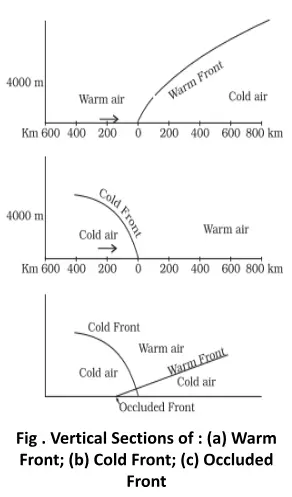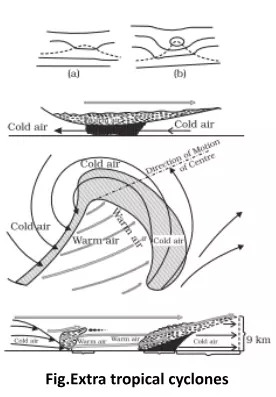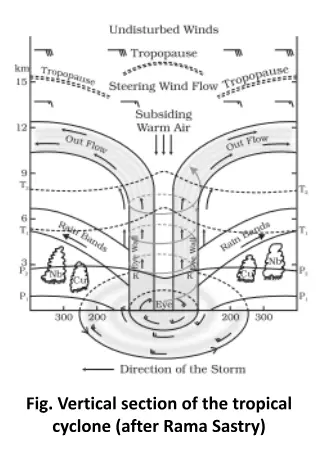![]() November 30, 2023
November 30, 2023
![]() 4124
4124
![]() 0
0
The Earth’s atmosphere is a dynamic and interconnected system, where various components work in harmony to shape our weather patterns. Among the key players in this atmospheric ballet are air masses, fronts, tropical cyclone, thunderstorms, and tornadoes. Each element contributes to the intricate dance of atmospheric circulation, influencing the climate and weather conditions we experience.
(i) Maritime tropical (mT);
(ii) Continental tropical (cT);
(iii) Maritime polar (mP);
(iv) Continental polar (cP);
(v) Continental arctic (cA).


(i) Large sea surface with temperature higher than 27° C;
(ii) Presence of the Coriolis force;
(iii) Small variations in the vertical wind speed;
(iv) A pre-existing weak low-pressure area or low-level-cyclonic circulation;
(v) Upper divergence above the sea level system.

Tropical Cyclones |
Extra Tropical Cyclones |
|
|
|
|
|
|
|
|
|
|
Thunderstorms and tornadoes are brief but highly destructive, typically limited to a small area.
Atmospheric circulation and weather systems are intricately connected, driving the complex dynamics of our planet’s climate. The movement of air masses, the formation of pressure systems, and the interaction of various factors like temperature, humidity, and geography all play crucial roles in shaping our weather patterns. Understanding these processes is essential for meteorologists and climate scientists to predict and study weather events, from the daily forecast to severe storms and long-term climate trends.
Pressure Gradient: The rate of change of pressure with respect to distance is the pressure gradient.
Coriolis Force: The rotation of the earth about its axis produces a force affecting the direction of the wind, this force was called Coriolis force.
Ferrel Cell: In the middle latitudes, the general circulation of the atmosphere cycle is called the Ferrel cell.
ITCZ: It is a low pressure zone located at the equator around 20°N-25°N latitudes where trade winds converge.
Isobars: Isobars are lines connecting places having equal pressure.
Land Breeze: Wind blowing from the land to the sea due to the pressure gradient generated in the day time.
Sea Breeze: Wind blowing from the sea to the land due to the pressure gradient generated in the night time.
Katabatic Wind: The cool air of the high plateaus and ice fields draining into the valley is called katabatic wind.
Air Masses: A body of air whose temperature and humidity characteristics, acquired in source region, remain relatively constant over a horizontal distance of hundreds to thousands of km.
<div class="new-fform">
</div>
Latest Comments